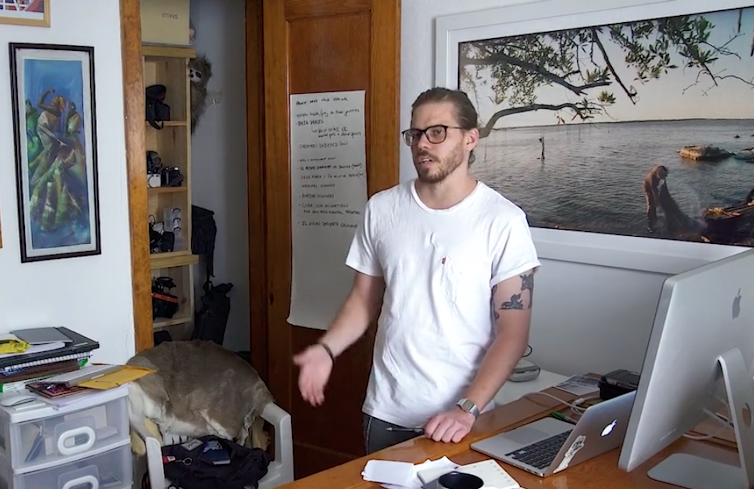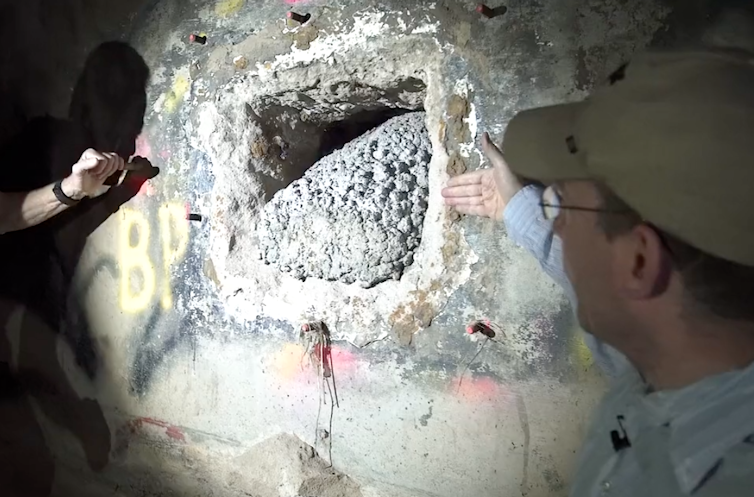With foreign bureaus slashed, freelancers are filling the void – at their own risk
- Written by Bill Gentile, Journalist in Residence, American University School of Communication
When Time magazine named journalists[1] who faced persecution, arrest or murder as their 2018 Person of the Year, it described them as “The Guardians” in the “War on Truth.”
It was a forceful rebuke to those who demean journalists as peddlers of “fake news” and the “enemy of the people.” But for freelancers who risk their lives in conflict zones, recognition does little to change the fact that they lack steady paychecks and security.
For decades, most leading media outlets have shuttered news bureaus abroad and cut the number of foreign correspondents on staff.
Since then, freelancers have increasingly filled the void. These include both Western journalists working in conflict zones around the world, as well as local journalists working in their own non-Western countries.
Foreign staffers the first to go
I became a freelance foreign correspondent when I moved to Mexico City in 1977. Two years later, I was a staff correspondent for United Press International.
At the time, Mexico was home to scores of staff and freelance journalists covering not just Mexico but also Central America and the Caribbean. But the number of both staff and freelance journalists based there has since declined, partly because the outlets for their work have downsized or disappeared, according to my interviews with colleagues who remain at their posts in the Mexican capital.
The change in Mexico wasn’t an isolated one. Beginning the late 1980s, the number of full-time staff journalists posted in foreign cities to cover stories of global importance started to drop. Studies showed this trend accelerated in the 2000s.
As journalist Sherry Ricchiardi noted in a 2008 article published by the American Journalism Review[2], “Foreign bureaus continue to fall like dominoes. The Boston Globe closed the last of its three international offices in Berlin, Bogotá and Jerusalem earlier this year. The Baltimore Sun plans to shut down South Africa and Russia by the end of 2007 and already has left China.”
In a groundbreaking 2004 report, “Redefining Foreign Correspondence[3],” authors John Maxwell Hamilton and Eric Jenner wrote that economic pressures, globalization and technological advances have all led to the “chronic decline” of the full-time foreign correspondent.
Hamilton and Jenner noted that newspapers were budgeting over $250,000 a year to support a foreign correspondent, with networks paying up to twice that amount for a television correspondent and their production team.
These estimates were from 2004. Today – especially in conflict zones – the cost of insurance and security measures could push the price for a staff correspondent or a TV crew much higher.
Survival of the fittest
Freelancers – much cheaper to employ – have largely taken the place of salaried correspondents.
Journalists that value flexibility and the chance to pursue stories that inspire them might now have more opportunities to get bylines in mainstream outlets.
But freelancing is tough work, and freelancers lack the support, preparation and security typically granted to staffers.
As photojournalist Dominic Bracco told me during a recent interview for my “Freelancers[4]” documentary series on foreign correspondents, “It’s difficult. There’s a lot of competition. There’s a lot of great people. You have to be better and smarter to survive. To make it in this career you have to work your ass off.”
Like many other freelancers, Dominic and his wife, Meghan Dhaliwal, also a photojournalist, spend much of their time pitching stories to a wide range of outlets, applying for grants, entering contests and forging personal relationships with editors.
 ‘You have to work your ass off,’ freelancer Dominic Bracco says.
Matt Cipollone, CC BY[5]
‘You have to work your ass off,’ freelancer Dominic Bracco says.
Matt Cipollone, CC BY[5]
Like most relationships, a freelancer’s connection with editors is founded on trust that’s built by producing outstanding work on deadline.
But freelancers, too often, are victims of a level of exploitation that most staffers don’t experience.
In a blistering Columbia Journalism Review article[6] about Vice News’ treatment of freelancers, Yardena Schwartz wrote that “in an era of journalism in which freelancers have grown accustomed to being treated like disposable cogs of news production, Vice appears to be in a league of its own.”
While freelancers are accustomed to late payment for their work, Vice seems to have simply stiffed many of its freelancers.
“Journalists who have worked for Vice tell CJR that the company published their work without paying them for it, promised them assignments which were later rescinded, and asked reporters for their help with documentaries that covered issues they had written about without any plans to pay them for their work,” Schwartz reported.
During a recent panel discussion[7] on freelancing at the Overseas Press Club in New York City, one foreign-based freelancer said he was visiting New York partly to pressure outlets that collectively owed him a total of $60,000 in late payments.
Staff correspondents rarely have to deal with issues like those cited in the Columbia Journalism Review article or at the Overseas Press Club. Most get monthly paychecks, medical insurance and regular hours. Before being sent overseas to a conflict zone, most now get safety and security courses, plus emergency medical training. If they ever are hurt or abducted, they and their families can count on their company’s support.
For example, in 1989, members of Peru’s Shining Path Maoist guerrilla group abducted Newsweek magazine staff correspondent Joe Contreras and me in that country’s cocaine-producing Upper Huallaga Valley. The magazine did all it could to rescue us before the guerrillas set us free two days after we were captured.
Venturing into the dark
Despite these obstacles, foreign-based freelancers continue to venture into some of the most complex and dangerous regions of the world.
Many report on crucial stories.
In 2013, freelancer Jason Motlagh spent nearly three months in Bangladesh reporting on the collapse of the Rana Plaza[8] building, the worst accident in the history of the garment industry and one that cost more than 1,200 lives.
In 2018, Christina Goldbaum joined The New York Times[9] after having worked four years as a freelance foreign correspondent in East Africa, where she spent a year in Somalia reporting on U.S. national security issues. While in Mogadishu she reported on the role of the U.S. military in the massacre of 10 civilians[10], the buildup of a secretive U.S. military outpost[11] 70 miles outside of the city, and details surrounding the first two U.S. combat deaths[12] in Somalia since Black Hawk Down.
Few staffers have the latitude to work on stories like these for such extended periods of time. If it weren’t for these two freelancers, the public would understand much less about the tragic human cost of fashion clothing produced in Bangladesh, or about the expansion of U.S. military activity in Africa.
Yet freelancers around the world often find themselves in harm’s way. In its annual report, the Committee to Protect Journalists[13] found that, as of Dec. 1, 2018, 251 journalists had been jailed for their work; of that total, 75 were freelancers.
 Freelancer Ioan Grillo points to a hole in a drainage tunnel underneath the city of Nogales, at the U.S.-Mexico border. Drug traffickers often cut through the tunnel wall to get into the United States.
Matt Cipollone, CC BY[14]
Freelancer Ioan Grillo points to a hole in a drainage tunnel underneath the city of Nogales, at the U.S.-Mexico border. Drug traffickers often cut through the tunnel wall to get into the United States.
Matt Cipollone, CC BY[14]
Perhaps in recognition of the more prominent role freelancers play in global news coverage, we’ve seen, in recent years, the emergence of organizations dedicated to supporting freelancers.
One of the most wide-reaching of groups offering support is the ACOS Alliance[15], a London-based coalition whose mission specifically is designed “to embed a culture of safety across newsrooms and among freelance and local journalists worldwide.”
Other groups offering assistance to freelancers are the Pulitzer Center on Crisis Reporting[16] and Sebastian Junger’s Reporters Instructed in Saving Colleagues[17].
As mainstream media increasingly turn their gaze from places far away toward internal issues, it is freelancers who take up the mantle of “guardians” of the truth.
Without them, our view of the world dims.
References
- ^ named journalists (www.newyorker.com)
- ^ American Journalism Review (ajrarchive.org)
- ^ Redefining Foreign Correspondence (www.researchgate.net)
- ^ Freelancers (www.thedailybeast.com)
- ^ CC BY (creativecommons.org)
- ^ Columbia Journalism Review article (www.cjr.org)
- ^ a recent panel discussion (opcofamerica.org)
- ^ Rana Plaza (pulitzercenter.org)
- ^ Christina Goldbaum joined The New York Times (www.nytco.com)
- ^ the role of the U.S. military in the massacre of 10 civilians (www.thedailybeast.com)
- ^ secretive U.S. military outpost (news.vice.com)
- ^ first two U.S. combat deaths (www.thedailybeast.com)
- ^ Committee to Protect Journalists (cpj.org)
- ^ CC BY (creativecommons.org)
- ^ ACOS Alliance (www.acosalliance.org)
- ^ Pulitzer Center on Crisis Reporting (pulitzercenter.org)
- ^ Reporters Instructed in Saving Colleagues (www.sebastianjunger.com)
Authors: Bill Gentile, Journalist in Residence, American University School of Communication

